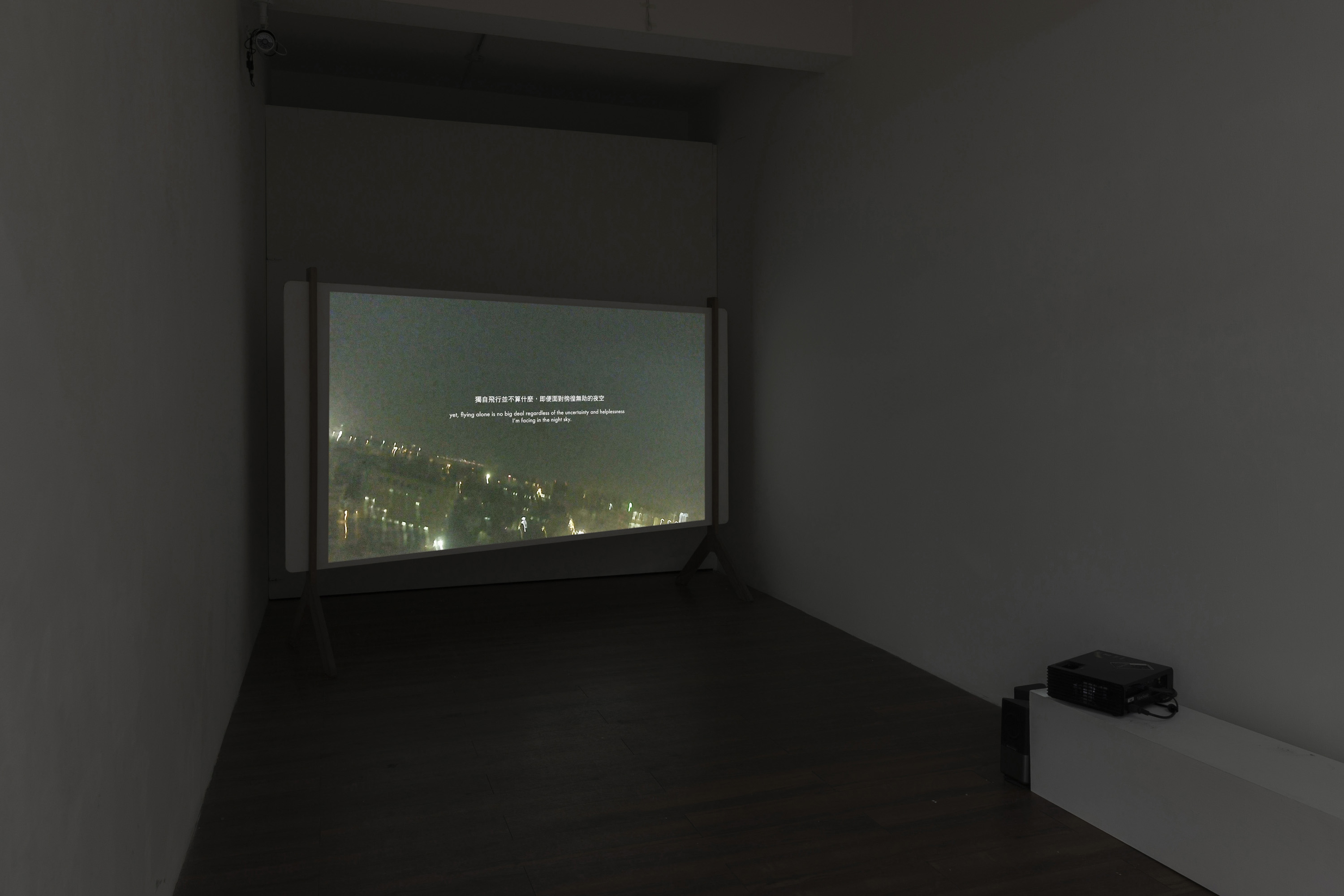一九四四年十月台灣空戰爆發後,在白天美軍的全面壓制下,入夜日軍也開始發動夜襲回擊,但沒想到是如此不堪一擊,最終還得託付這群軍鴿。人類利用鴿子冒著相當高的危險性來執行任務,他們面對著未知的天際,展開出生入死的探險。我無意間閱讀到世界經典名著「小王子」的作者安東尼.聖修伯里(Antoine de Saint-Exupéry)的另一件作品「夜間飛行」,也是透過飛行來描述當年如何在夜間的高空下,以超越自我的勇氣去克服種種的困難,卻又在面對神祕未知時,不免心生畏懼,暴露出人性的弱點。同是主人翁的小說主角與化身為鴿子的我透過真實的飛行體悟,真切地道出自我內在的掙扎以及對生命的不安。
而我這檔展覽作為「台灣空戰記事」最終章,則刻意挪用「夜間飛行」這文學作品名,並聚焦於小王子作者與我的鴿子之間平行宇宙的交會。展覽不再描述戰爭血淚,轉向強調重新演繹的事件幕後鴿子與創作者的角色位置。作品敘事仍以軍鴿作為手段,在情蒐偵察任務下所得的情報,也對應到殖民流動下的空間轉換、資本開發與殘生空間消逝等問題。重返歷史現場拍攝的錄像則以擬人兼旁白描述當年軍鴿的面目,而不斷重複訓練彷彿薛西弗斯式的鴿子(與我)也藉機展開一系列影像、空間與身體的喃喃自語,意圖以他者之眼編織的視覺狀態,透過微細歷史事件的提示、鴿子身體徒勞的對價來抵抗對當下所處的生活環境。
After the outbreak of the air battle in Taiwan in October 1944, the American air force had total command of air during the day. This led to counterstrikes at night by the Japanese air force. Unfortunately, Japan’s military capabilities by now were simply too weak to undertake the task. Eventually, military pigeons were entrusted for the mission. These pigeons usually carried out tasks at very high risk as they were faced with the unknown situations in the air. It was a matter of life and death. I came across a novel called “Night Flight,” written by Antoine de Saint-Exupéry, the author of a world classic “The Little Prince.” The book also relies on flying to show the oxymoron between human beings’ strengths and weaknesses. In the novel, one is courageous enough to transcend oneself and overcome various difficulties while fearing the consequences of uncertainties ahead. The flying experience embodied by the novel’s protagonist and a war pigeon as my reincarnation faithfully reveals my inner struggle and anxiety about life.
In the final chapter of “the Memo of Formosa Air Battle,” my exhibition deliberately appropriates the title of the literary work “Night Flight,” and focuses on the intersection of the parallel universes between the author of “The Little Prince” and my military pigeon. The exhibition no longer features the theme of blood and tears in the war, and shifts to the roles of pigeon and creator in the reinterpretation of the event. The narration of the work still uses military pigeons as a means, and the intelligence obtained through reconnaissance activities also corresponds to the problems of space conversion under colonization, capitalist development, and disappearance of residual space. The video that was filmed at the historical site attempts to reconstruct the historical scene to describe the situations of military pigeons with personification and narrations. The pigeons (and me) that underwent repeated training as if they were Sisyphus developing a series of muttering composed by images, space and body. This signifies the visual effects created through the eyes of others and through the hints of nuanced historical details, the futile resistance of pigeons against their then living environment.
夜間飛行 – 台灣空戰記事 終章,李立中個展,台北台灣,2021
錄像、攝影、手繪、剪報、檔案文獻
尺寸依現場而定
Night Flight - The Memo of Formosa Air Battle, The Final Chapter,
Lee Li-Chung Solo Exhition, Powen Gallery, Taipei Taiwan, 2021
Video, Photography, Hand Painting, Newspaper Clippings, Archive Files
Dimensions Variable
+
如果有一種飛行 —李立中「夜間飛行」的歷史擬造
藝術家雜誌557期 10月號當代藝術 |許楚君
紅野畫廊「李立中:夜間飛行—台灣空戰記事 終章」
台新獎ARTALKS特約評論|高森信男
再繪無人知曉的歷史 李立中「夜間飛行-台灣空戰記事 終章」
今藝術投資347期八月號 SPOTLIGHT|嚴瀟瀟
當動物形成人的感官──談「夜間飛行」的鏡頭與書寫
七年級詩人、書寫者、藝評家|印卡
|















